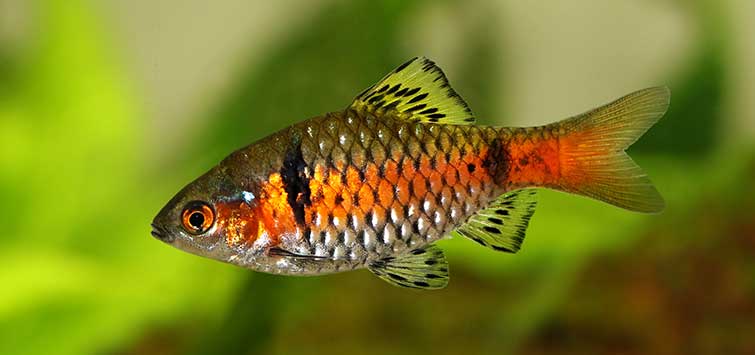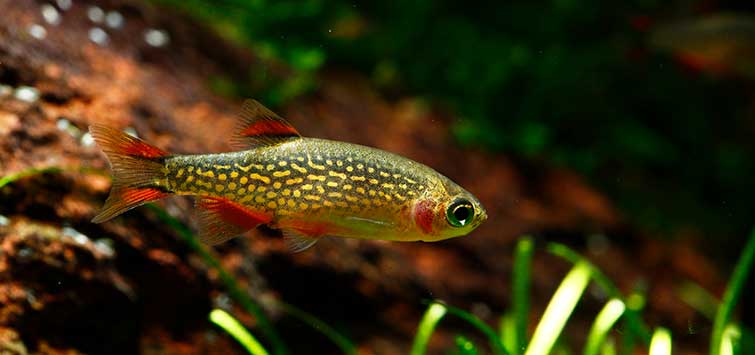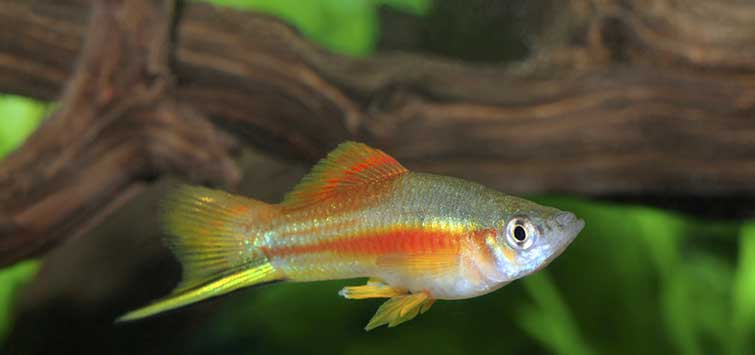Top 10 Barbs for the Community Aquarium
Author: Mark Denaro
A longtime fishkeeper and importer lists his picks for the best barbs to place in your community setup, and explains which popular species may be better left out of your tank.
Barb Basics
When the topic of barbs comes up among aquarium hobbyists, we all have a pretty similar idea of the fish we are discussing. The common name originated from members of the genus Barbus. Unfortunately, this became a catch-all genus with many widely varying species being lumped together. This, in turn, led to the genus Puntius, which also became a catch-all. A significant revision of the genus Puntius is underway, which is resulting in the formation of new genera and these fish being accurately described and divided along taxonomic lines.
While the scientists resolve their confusion, we still know what we mean when we use the common name “barb.” This big, somewhat unwieldy grouping can be divided based on size into those that are suitable for aquariums up to 75 gallons (284 liters) and those that will do best in larger aquariums. There are many members of both groups, and quite a few are very popular with hobbyists. This month, we’ll take a look at the smaller barbs, and I’ll rank my top 10 for the aquarium.
Ranking Criteria
I used two primary criteria to create this list. First, the species in question must be suitable for aquariums of 75 gallons or less. Second, the species must be available with some regularity in the aquarium trade. That means that we are pretty much limited to Asian species. There are three African barbs that would likely have made the list, the Jae barb (Barbus jae), the banded barb (Barbus fasciolatus), and the butterfly barb (Barbus hulstaerti), but their rarity in the hobby precluded their inclusion.
So, let’s start at the bottom of my list and work our way to the top:
10. Tiger Barb (Systomus tetrazona )
Despite being one of the most popular species in the hobby, the tiger barb is also one of the most misunderstood and is frequently a contributing factor to the loss of new fishkeepers from the hobby. Tiger barbs are best kept in schools of at least 10 fish. When kept in smaller groups, and especially when kept as a pair or a single fish, they can be particularly nippy toward other fish. In bigger groups, they are less likely to bother other species. It is all too common for a new hobbyist to purchase one or two tiger barbs only to see them terrorize other smaller fish in their tank and, in many instances, kill smaller fish, such as neon tetras. This in turn can lead to disillusionment and the loss of people from the hobby.
When maintained in a large group in tanks of at least 30 gallons (113 liters)—due to its 3-inch (7.5-cm) size—this is a delightful species. It is active, inquisitive, and colorful. A number of other color forms, such as albino, green, and black, have been developed through selective breeding, and they will all school together. Close to 100 percent of the fish in the hobby are bred in captivity, but wild imports are occasionally available. Captive-bred fish typically have more red in their fins than their wild counterparts.
Unfortunately, dyed specimens are also available, but I would encourage you to purchase only naturally colored fish. The tiger barb is also among the species that have been genetically modified to exhibit fluorescent coloration. Due to its behavioral issues, I believe that this was a less-than-perfect choice for this purpose.
9. Stoliczkae’s Barb (Pethia stoliczkana)
If this species were more readily available, it would probably have ranked higher. It is available occasionally, and anyone who wishes to own a group should be able to obtain them. This subtly colored, peaceful species sports red fins and grows to 2 inches (5 cm) in length. The minimum group size should be six fish, and a 20-gallon (76-liter) long or larger tank is best.
8. Rosy Barb (Pethia conchonius)
This is an oldie but a goodie. It’s been in the hobby for a very long time and is available in a number of color variations and long-finned varieties. In the wild type, males are red and females are a brassy gold. When males are in spawning condition, their color intensifies. This species grows to 4 inches (10 cm) and can be kept in groups as small as four fish.
Now for the things you may not know. First, it’s an excellent choice for unheated aquariums and does very well in an outdoor pond from approximately Mother’s Day weekend to Labor Day weekend in most northern climates. Second, rosy barbs are absolutely the best species for eradicating beard or black brush algae (BBA). In fact, BBA seems to be their favorite food source, so if you’re really into planted tanks, it’s a good idea to keep a group of rosy barbs around just for algae control. You can either move affected plants or decorations into their tank or move the barbs from tank to tank.
7. Melon Barb (Haludaria fasciata)
The melon barb has become increasingly common in the aquarium trade over the past 10–15 years. I’ll never forget the first time I saw one back in the late ’90s when I judged it at a Medina County Aquarium Society show. This beautiful species occurs in several distinct geographic forms that may be described as separate species in the near future.
If you intend to breed it, try to get as much information as possible about where your fish were collected, and don’t cross-breed fish from different locations or you may be unintentionally creating hybrids. All forms feature a gold-orangish body with black spots and bars and sometimes a green sheen overlying it all with red in the dorsal. Growing to less than 3 inches (7.5 cm), melon barbs can be kept in setups as small as 20-gallon (76-liter) longs, but 30-gallon (113-liter) tanks are definitely preferred. The group should consist of at least four individuals.
6. Rhombo Barb (Systomus rhomboocellatus)
A member of the Systomus tetrazona species complex, both species will probably be assigned to a new genus fairly soon. This species also goes by the common names snakeskin barb and orange barb, with the latter providing a good indication of the ground color. There are odd, almost teardrop-shaped black markings on the side that feature a “hole” in the large black area. This combines to make a beautiful package for a peaceful species that grows up to 2½ inches (6.5 cm), making it suitable for aquariums as small as 20 gallons (76 liters). There should be at least four fish in any school.
5. Odessa Barb (Pethia padamya)
Not that long ago, this species was very hard to find, but these days, the Odessa barb is one of the most common barbs in the hobby and can readily be found in most aquarium shops. Despite being well known to aquarists, Pethia padamya wasn’t scientifically described until 2008. The common name Odessa is something of a misnomer. The species first appeared in the hobby in the Ukraine and was presumably imported through Odessa, hence the common name. In reality, this species hails from Myanmar, where the species name means “ruby” in the local dialect.
This is a silver fish with dark edging to the scales and black markings on the body and in the fins. Males feature a red, horizontal band on the mid-body when they are in good condition. This species can be kept in unheated aquariums. It grows to less than 2 inches (5 cm) and is suitable for tanks of 20 gallons (76 liters) or larger. Schools can be as small as four individuals.
4. Gelius Barb (Pethia gelius)
Sometimes known as the golden barb or the dwarf golden barb, this is the smallest species in our countdown, growing to only 1½ inches (3.8 cm). As such, it is well-suited to 10-gallon (38-liter) or larger aquariums. This gregarious species should be kept in groups of at least five fish. The color varies somewhat, which may be due to geographical variation and could possibly indicate that this is an assemblage of species rather than a single fish. When happy, it is a beautiful golden-yellow with black markings. Males are more colorful.
3. Black Ruby Barb (Pethia nigrofasciata)
This is the first real contender for the number-one spot. The color pattern of the black ruby barb is reminiscent of the tiger barb, but this species has more iridescence on the body. In addition, males become a beautiful shade of ruby red that is so dark, it’s almost black, hence the common name. The colors become even more beautiful when the fish are kept in an outdoor pond. They are a wonderful addition to the water garden, not just because of their color, but also because of their activity level, the amount of time they spend near the surface where they are visible to the pond keeper, and their voracious appetite for mosquito larvae.
In the aquarium, they should be kept in as large a school as possible, with a minimum number of six. P. nigrofasciata seldom exceeds 2 inches (5 cm), and its aquarium should be 20 gallons (76 liters) or larger. Their colors show particularly well in planted aquariums, and a large school of black ruby barbs along with a school of a surface-dwelling species, such as a danio, makes a truly spectacular display in a planted tank of at least 30 gallons (113 liters). Not nearly as nippy as the tiger barb, this species is a far better choice for most community aquariums.
2. Gold Barb (presumably a selectively bred color variant of Puntius semifasciolatus)
The gold barb was developed by Thomas Schubert in New Jersey in the 1960s. A friend of mine knew him and claims that Schubert taught him everything he knows about the hobby. Interestingly, though, Schubert never allowed him into the room where he bred the gold barbs. So, is this a selectively bred color form or a hybrid? We may never know for sure. Regardless, it’s a beautiful fish and a real standout in any tank, but especially in a planted aquarium.
The bright golden-yellow color really stands out against a background of green plants. There are black markings and sometimes some deep green on the body. The fins are red. Males are more brightly colored and more slender-bodied than females. Gold barbs can grow to 3 inches (7.6 cm), but usually top out at about 2¼ inches (5.7 cm). They can be kept in 15-gallon (57-liter) or larger aquariums, and the bigger the group, the better, with four being the minimum. Gold barbs are a very close second in our countdown.
1. Checkerboard Barb (Puntius oligolepis)
While there were some close contenders, there wasn’t any real doubt in my mind that the checkerboard barb would be number one. I’ve been very fond of this species since my early days in the hobby back in the 1970s, and it was one of my signature species in planted aquariums when I was doing aquarium installation and maintenance.
This species grows to only about 1¾ inches (4.5 cm), is a great addition to tanks of 15 gallons (57 liters) or more, and should be kept in a group of at least four fish. The leading edge of the scales is black, which gives it the checkerboard look. The body color varies from brassy-silver to chestnut-brown on the males while females are more silvery. Males also have more brightly colored unpaired fins, which are typically orange to red and feature black edges.
In small groups, this species does not school very tightly. They will roam as individuals and then come back to form a school, only to repeat the process. Males will display for each other as well as for the females. Checkerboard barbs spawn readily in planted community tanks, scattering their eggs among the leaves.
So, Where’s the Cherry Barb?
I hope I’ve presented a list of species that will pique or rekindle your interest in barbs this month. There is one very common, very popular species that did not make the list, and I feel that requires an explanation. My experiences with cherry barbs have never been very good. I find them exceptionally prone to velvet and other diseases. They frequently experience shipping stress and don’t hold up well in many shops and importers. Consequently, I did not feel they warranted inclusion, but I certainly understand that many people would have them in their own top 10 lists.
See the full article on TFH Digital http://www.tfhdigital.com/tfh/june_2014#pg57

.png?h=595&iar=0&w=2781&hash=5FD5E69473BCC22199FBFA2FB71B6033)




